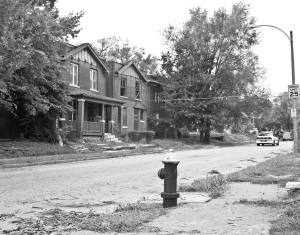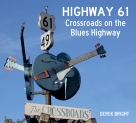…confronts visitors seeking out the Greater Ville neighbourhood of North St. Louis, where Chuck Berry grew up. Photographs of the area’s architecture together with the neighbourhood’s history and reminiscence’s from those that once lived in the Ville can be found at Mark Groth’s excellent St. Louis City Talk site. Just a few miles northeast along Dr Martin Luther King Drive one passes a little south of Ferguson, a suburb of North St. Louis where street protests re-ignited following a Grand Jury decision not to indict Police Officer Darren Wilson following the fatal shooting of Michael Brown, a young African American in August. Pamela Engel writing for Business Insider just days after the death of unarmed teenage Michael Brown described St. Louis as one of the most segregated cities in America, where racial tensions ‘have been boiling over for years’. Reading reports as events in Ferguson unfolded did not come as a complete surprise visited many parts of the city that had sites which had been connected with the history of blues music. On one such day, following a morning’s trip over to East St. Louis in search of the site where the Cosmopolitan Club had stood, the venue where Chuck Berry had started his career with pianist Johnnie Johnson in the Sir John’s Trio, we returned across the Mississippi River from Illinois back to Missouri.

The Martin Luther King Bridge took us back over the Mississippi to St. Louis and we made our way along Dr Martin Luther King Drive for a few miles, passing through North St Louis towards the Ville neighbourhood where Chuck berry grew up. As we drove further through North St Louis and away from the downtown area the deterioration of the brick built properties that lined the avenues either side of Dr Martin Luther King Drive became starker. Yet it was clear that these avenues had once been impressive and sought-after residential areas.
The shops on the opposite side of Dr Martin Luther King Drive had been boarded up, as had a good many other properties, and as we turned off the main thoroughfare we were met once again by a series of vacant lots with patches of grass where buildings had once stood. A little way along the street a number of brick villas stood, characteristic of the architecture to be found in North St. Louis. Some of the buildings were in good repair but others had missing windows, roofs partially stripped of their tiles, and shuttering nailed over any opening that would allow access.
Berry was born in a three-room brick cottage at 2520 Goode Avenue. Situated in a nicely kept area in the best of the three black sections of the city, it is from Goode Avenue that the country boy and protagonist in the song takes his name. Ironically the hero of the song was originally penned as a ‘coloured boy’, but was subsequently change by Berry to ‘country boy’ when he recorded the song, so as not to alienate a white audience. [see Berry, The Autobiography, 1988] Partly autobiographical, Johnny’s life is a metaphor for the development of blues music (or at least one view of it); rather than being born in St. Louis, Johnny is born in a log cabin near New Orleans. Berry places Johnny’s log cabin at the beginning of the African American experience, a place that Berry interestingly describes as the ‘gateway from freedom’ that he ‘was led to understand, was somewhere close to New Orleans, where most Africans were sorted through and sold’ [Berry, 1988].
From the book Highway 61 – Crossroads on the Blues Highway [History Press] 
